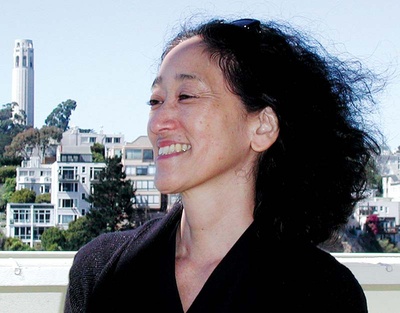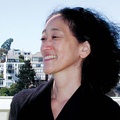I flew out to California on 12 November 2009 to interview Karen Tei Yamashita on the eve of the publication of I Hotel, her newest work. We began the day in conversation over lunch, moved to a more formal interview conducted at her home, and ended with dinner. What appears here is an edited version of our conversations, constructed from a recording and my notes, and refined thereafter by both of us. What this text fails to capture is the graciousness and generosity of time and engagement that Yamashita showed throughout this process. She speaks of the “purposeful generosity of ego” in describing others; I think that could equally describe Yamashita herself. As importantly, the hearty sense of irreverence remarked upon by other interviewers, and a gleeful sense of humor that informs the seriousness of the literary craft she undertakes—these don’t come across nearly as much as I would’ve liked. These failings are mine as an interviewer and writer; apart from the opportunity to talk with her in person, her work is perhaps the best way to experience these characteristics.
I Hotel is in many ways a magnum opus. It runs some 630 pages, includes images and graphics, and represents a decade worth of research and writing and creativity. Readers familiar with Brazil-Maru, Through the Arc of the Rain Forest, and Tropic of Orange, Yamashita’s earlier published novels, will find ample evidence in this latest of the imagination and skill of those works. Of its central thematics—and the interview below speaks to many of them—I found especially striking its deep engagement with the work of writing itself—storytelling and representation—and its recognition of the untidy, ironic, and passionate individual and collective histories that together describe the “Asian American movement.” Yamashita’s work operates in what I have been thinking of as a kind of palimpsestic realist mode, where the detailed experiences of individuals are juxtaposed with others, with historical movements, politics, and institutional formations.
* * * * *
Kandice Chuh (KC): I Hotel has a soundtrack to it, more distinctly and prominently in some sections than others, but clearly present throughout. In what ways is this an important aspect of the work?
Karen Tei Yamashita (KY): You’re not the first to suggest that it has a soundtrack. A friend suggested publishing it with a cd of music. But I imagine it would be difficult in terms of copyrights and the expense to make that happen. Music was so much a part of the era I’m writing about that it had to be present in the story.
KC: In some ways, I Hotel reminded me, despite their obvious formal differences, in ethos, of Brazil-Maru more so than your more recent work.
KT: Yes, that’s probably true. This book is based on a lot of research, like Brazil-Maru.
KC: To what extent are you aware of the critical discourse around your work?
KT: Oh, I read everything written that comes to my attention, or I try to. I find it interesting to read what others see in the work. Sometimes I find it funny. Sometimes very moving.
KC: In a draft of the book—in the version that I read—there is an introduction that focuses on laying out the process. What motivated that introduction?
KT: Oh, it’s now an afterword. Jessica Hagedorn read the draft with the introduction in the front and said, what’s it doing there? She was peeved to find a novel of fiction acting like an academic work. The reason it’s there, I realized, is for academic reasons—because I had to put the book forward to justify my case for what the university calls a merit increase in pay. Also, I had been, along the way, trying to get funding for research for this project, and this explanation was the proposal.
KC: I understand the structure of I Hotel as different novellas, but it also felt like a novel to me. Because of repetition of the setting, and time, and characters—there’s a sense of continuity. The rationale you’ve offered in what is now the afterword is that the material didn’t lead into a novel form. But is there a way that the conventional novel was inadequate to the material?
KT: If the conventional novel is a single story line with a single set of characters, I guess not. At some point, I realized the work had to be layered with multiple trajectories. Actually, the whole book started out with the boxes [that graphically represent and mark the beginning of each novella]. I started to think about the hotel as architecture with rooms. Something along the lines of Ship of Fools, maybe—people in multiple layers riding this ship across the ocean. As I began to configure the work, I also knew, because of the endless material researched, that I needed a structure to limit myself. Thus the division of the novel into ten novellas.
KC: I was thinking about this book in relation to your other work, and I kept thinking that there’s always a deliberate attention to form, to crafting the structure of it, but it struck me in this text more than any other, and now when you look across that corpus, there seems to me something like the emergence of a new novel form—it’s not quite pomo, poco, not “Asian American,” whatever that might mean—and the term that kept coming to me was “palimpsestic”—that your forms have always been about the layers. You know, in the ways that Manzanar (the character in Tropic of Orange) sees the subterranean and all the different levels of Los Angeles in layers—that felt to me the ways that your novels work. To what extent is this deliberately crafted? Are you guided by the material and that’s what comes out, or is it a commitment to formal experimentation that we’re seeing?
KT: Both. I would say that I spent about 10 years doing the research for this book, and there was a moment at which I had to stop to write. I knew what the center of the book was, but I didn’t know how to present all the material, and I didn’t want to ignore any of it. I was interested in all the crossings—the intersections of people who did not know what others were doing. There was so much factionalism at the time—people weren’t really talking to each other; for example, the artists and the political activists knew but avoided each other. I didn’t know what the form would be until I sat down and tried to figure out all of these trajectories. What form would be creative but also would speak to all of the story layers? So yes, the form is an experiment, but it’s also about the best way to tell the story. The form speaks to the material.
KC: That’s one of the pleasures of reading your work—that the form is intimately connected to the material that you couldn’t imagine.
KT: I was also consistently worried about the length of it, and yet I thought, if I could parse it out in this fashion, then people could read the sections they want to read. Each novella is compact in itself, tells its own story.
KC: It’s quite funny, it has quite a sense of humor—appropriately so.
KT: And maybe also inappropriately so. I wonder about that, if there will be people who think that I didn’t treat the material with a certain kind of seriousness. But I am incapable of writing sans humor, and I also thought that this would be a way to reveal or critique things that went wrong. Humor can be a way of looking back and laughing. When I interviewed people, some of the stories were related in a humorous vein but also with embarrassment—“We punched each other out; we fought on that truck; how stupid was that?”—that’s embarrassing, that’s painful to think about or read again, but at the same time, how else can we approach this past? You know, these were 20 year-old kids who were fiercely passionate about what they were doing. I remember those days; I was ready to punch people out—I was very angry.
KC: What was your relation to this period?
KT: I lived maybe the middle period of it. People who were really into it in L.A. were people like Mo Nishida, Warren Furutani, and Pat Sumi. I was on the younger end watching what was happening. I graduated high school in 1969 and had some kind of relationship to it through high school in Gardena, in Los Angeles. I wouldn’t say Gardena was Asian American; it was Japanese American—maybe 50-60% Japanese American, sansei children of nisei who come out of the camps. So there was an investment in this new vision. As high school kids, we would go over to Long Beach State where they had potlucks and events and were rallying the movement.
When I made decisions for college, I decided I wanted to get out of California and went to school in Minnesota. At Carleton College, I met two students in particular, Marsha Tajima and Mark Tajima, siblings of the Tajima family—[documentary filmmaker] Renee’s older sister and brother. They were from an activist family in Southern California. At Carleton, Mark decided that we needed an Asian American group to represent, so he brought people from Yale and from UCLA and put on the first conference. And while we were there, Kent State happened, Cambodia happened. We were part of a war moratorium, conducted classes outside on the green, and marched on the state capital.
KC: So, when you’re writing about that in “1969,” is the texture of that novella partly from you? I mean, clearly it’s from your research and interviewing work, but is that also from your memory of how it felt?
KT: Maybe. Or maybe it’s about me trying to recuperate a time in California that I experienced from the midwest.
KC: Because there is some sense that there was just a lot—almost too much going on—to actually be able to synthesize it in the moment, so all you can do is sort of mark it out. And then it’s not until the film in the next section that we get the sense of, okay, this is what’s happening, so that there’s always a removal of space and time—you need somebody else’s narration of it—before you can figure out what’s happening for yourself.
KT: The first chunk—that first novella—was written over a period of a year. By then, I had pretty much structured the entire novel, and I had made some decisions about each narrative voice. I used the first novella to develop each of the voices that would then be attached to each novella.
Perhaps that first novella had its start with a class I did in Asian American literature in which every week we looked at a different ethnicity. You know how it is. You do the Chinese, then the Japanese, then the Koreans, and then the Filipinos…I created a class in which there were 30 books—it was a really dumb thing—the students had to read 10 books, but I had to read all 30. I gave students a choice of genre—a novel, or a book of short stories, or it could’ve been a play or a book of poetry; one week all the texts were Chinese American; another week, they were all Japanese American. Admittedly, I chose the texts for some kind of conversation between them. Students had to choose one book to read but be familiar with all of the works via student presentations. I began to figure out what my lectures would be, and as it turned out, the lectures were mostly on narrative voice. Narrative voice is anyway a project I’ve been doing for awhile. I was amused to discover similar resonances of voice across poetry and prose in any one ethnicity. What makes a Chinese American narrative or a Korean American narrative? I was a little confounded by what narratives reveal, but I wanted to reproduce some of that in this book; that was a part of the literary project or question. It’s not exactly as I thought it would be in the beginning; now it feels more parodic, as mimicry, but also as my reinvention of ethnic voice. So it took me about a year to figure out each of those voices, including one that never repeats itself; however, there are ten different narrative voices.
KC: One of the interesting effects of that is, as a reader, I was very aware at various moments of the address, in a way that I don’t think I had been in your other works. Because there was such a distinctive narrative perspective or voice that was being used at various moments, at some moments I thought, oh, this is really a direct address, and at other moments, I thought, I’m completely irrelevant to the conversation that’s happening in the text. And I thought that was really fascinating that, over the course of 630 pages, there was a sort of negotiation because usually when I’m in a big book, I’m just in it, and I don’t have a kind of critical thinking on; I’m just reading. But that was almost impossible to do here at various places. At other places I was totally lost in it, and I had to remind myself that I was reading it for work.
KY: Well, what did you as a reader really want? I mean, did it bother you that you had to negotiate the voices?
KC: I think I found it especially satisfying—because it satisfied both the pleasures I find in just reading, but also the sort of secondary pleasures as a critic, of being able to notice that I am finding pleasure in the reading, and being able to try to identify the craft of it, because it was clear that there was actually a design in what was happening. So, that for me is really what I enjoy.
I was thinking about the multimedia presence in this text, and I was thinking about this in relation to the fact that, I think, one of the major thematic interests of the book, in a more explicit way than in your other work, is actually writing itself—the act of storytelling, the limitations of it, the potential of it, the responsibility that attaches to it. Can you talk a little bit about that in relation to the presence of dance, and film, and poetry and prose—there were even moments at which I thought that there was sculpture present, you know those places where you have Fa Mulan where you have “real” and “fake” on the pages; they feel very fine arts. What’s the comment there? What’re you trying to look at or suggest?
KT: The novella you’re talking about [in which Fa Mulan appears] is Aiiieeeee Hotel. What I wanted to do with that novella was to recuperate the beginnings of the artistic movements that were born in this period by Asian American artists. I wanted to recognize that that wasn’t just literary, but that all these different art movements were politically motivated within an idea of Asian American participation. So, the participation could’ve been photographic; they could’ve been producing film; they went to radio to do radio arts; they were doing dance. So many were part of this arts movement. I also began to think about the production of art as not just a political ambition of the period, but also an artistic renaissance.

Karen Tei Yamashita on the roof of the re-erected International Hotel in San Francisco. Author of "I Hotel" (Coffee House Press). Photo by Mary Uyematsu Kao.
* * *
Karen Tei Yamashita is a Japanese American writer whose pioneering works of fiction include Through the Arc of the Rain Forest, winner of the American Book Award and The Janet Heidinger Kafka Award, Brazil Maru, named by The Village Voice one of the 25 Best Books of 1992, Tropic of Orange, finalist for the Paterson Fiction Prize, Circle K Cycles, and the forthcoming I Hotel.
* * *
* This interview will be published in The Asian American Literary Review, Issue 1 (April 2010). AALR is a not-for-profit literary arts journal, a showcase of the best of today's Asian American literature. To learn more about the journal or purchase a subscription, visit us online at www.asianamericanliteraryreview.org, or find us on Facebook.
© 2010 Kandice Chuh





